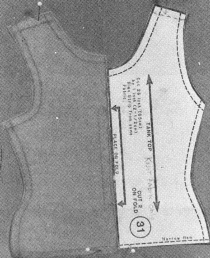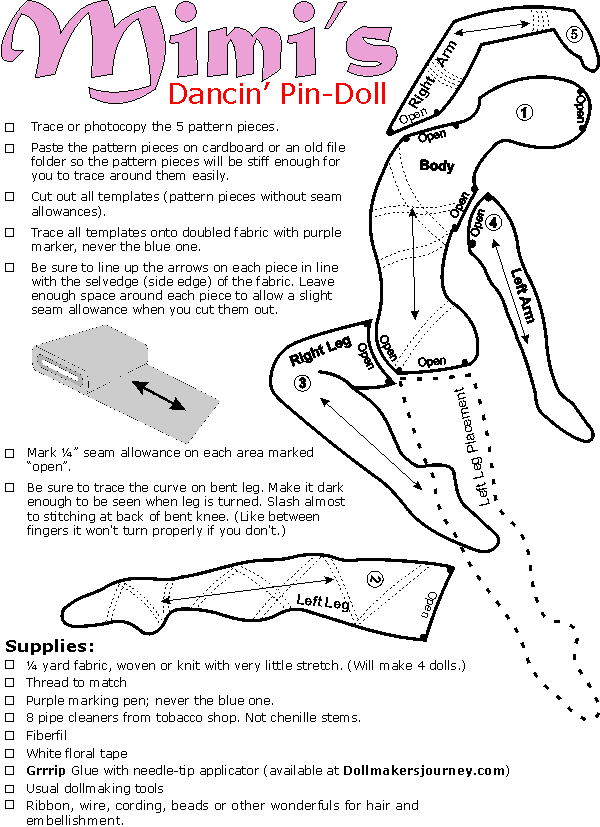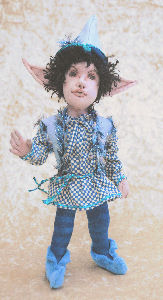Here are pages 109 – 116 of Mimi’s Earth Angels Storyboard Workshop. This section begins with how to build a character and ends with picture-by-picture instructions for fitting the clothing to your particular doll.
Building a Character
A doll becomes alive when it is “somebody” instead of “something.” To a child, with a free imagination, a handkerchief doll, a clothespin doll, a pipe cleaner doll or a Raggedy Ann doll is “somebody.” Each doll has a name and a life of its own. The child invests its own emotion into the doll to make it live.
To an adult, a doll must invoke an emotion, or the memory of an emotion to seem alive. If the doll invokes a memory of times past, or of childhood dreams unfulfilled, it will live only in a collection on a shelf with the faded memories of childhood. If the doll’s life is strong enough to bring out the child within the adult, it can lead to fulfillment of those lost dreams. But if the doll creates an emotion and life in the present tense, through a sense of empathy and wonder, by recalling and recreating the human condition, then It becomes sculpture or Art. Then has the doll’s creator gained immortality by communicating beyond the bounds of time.
Let the Doll Come Alive
She was a dollmaker.
She made what she could of the doll,
until it came alive in her hands
and made what it could
of itself.
Creating a living doll is like creating anything else: at some point, the doll will take over and shape itself. The wise dollmaker knows that there is a time for discipline to enforce the basic shape of humanity, and a time to let go and let what will be, be.
Planning a Character
As an artist, you have a certain idea of what you would like to create — what it looks like, what it feels like, what it says to others. It is easiest to control the appearance of your work, for that you shape directly with your hands. You can plan the appearance of your doll by selecting the skin, eye, and hair colors, the racial features of the face, and the cut, colors, and style of the costume. This book has tried to show you how to make your doll dreams into reality.
A living character is more than appearance. You plan a character by giving it a name, a biography, a pose, and a costume. If the sum of these things forms a whole and evokes an emotion in the viewers, your work has life
If you are sensitive to it, your work will tell you its name and biography as you shape its body. Then you need only add pose and costume to help it express itself.
Naming Your Character
Like a person, a character has a name. For our children, we look through books for the meanings of names in the hopes that our children will live up to the name we give them. More primitive peoples wait until the child is older (to be sure it will survive), and base the name on the character the child has already shown.
You may name your doll before you begin, or you may wait until your doll tells you who she is. If you choose the name first, your doll will try to live up to her name. If you let your doll choose her own name, you will learn something from her.
Biography Builds Character
A biography expands on your doll’s name by giving her a past and a future. A student of psychology will recognize that the past controls the body language of the present and the expectations of the future. The past shows in our pose, expression, costume, and image. It dictates both how we perceive and treat ourselves, and how others perceive and treat us. By giving your doll a past, you determine her future.
A biography need only be a sentence or two. Where does she come from? Who were her parents? What are her aspirations? Then pose her and dress her accordingly.
Posing and Expression
We recognize expression by the shape of the eyes and the mouth, by the tilt of the head, by the bend of the elbow or knee, by the curl of a finger — by all those things which reflect our inner state of mind upon our body. You must sculpt the shape of Earth Angel’s face when first you make her. It is one of the things that will tell you who she is, To make her body match, you need only put the same expression on your own face and allow your own body to flow Into the matching position. Then copy the body language Into Earth Angel’s pose. Her head will twist and tilt. Her elbows and knees can be ladder stitched in any position. Her wrists will twist and turn. Her fingers will curl and close.
Costume and Image
A costume and its accessories merely refines the image of the character and makes it more obvious to the viewer. The right costume accentuates the character, even when the character is hiding behind the costume.
Princess Askara looks regal without her costume. “Princess” is built into her face and her posture. The costume merely tells you why she is regal.
Similarly, an Angel of Punk Rock tells you that she is hiding and afraid to let the world see who she really is, because the world might see her as nobody. Her costume says: “Look at me!” but her body language says: “I am just like all the others — you can’t tell I’m not really here.”
Earthbound Angel
Titania,
born not of the Families,
must abandon her wings,
bid freedom to Pegasus,
and become an Earthbound Angel
In whose life
the Seeds of the Wheel are sewn.
Diana de Los Angeles
 Diana de Los Angeles was born with a golden spoon in her mouth and a silver chalice at her side. She lives in Marina Del Mar on-board a 48 foot Choy Lee trawler. She can tell you to the last monel screw why she thinks the Choy Lee is better than the Grand Banks trawler, and why none of the other trawlers are worthy of the name. She also owns a 51 foot Morgan Out Island ketch that she charters in the Caribbean. It is rigged for single-handing from the cockpit. She has participated in the Around-The-World Solo Sailboat Races. She is at home with a LORAN or a computer, or doing a major engine overhaul at sea. She has survived a hurricane at sea by lying awash. She has been knocked down and rolled over, but never defeated.
Diana de Los Angeles was born with a golden spoon in her mouth and a silver chalice at her side. She lives in Marina Del Mar on-board a 48 foot Choy Lee trawler. She can tell you to the last monel screw why she thinks the Choy Lee is better than the Grand Banks trawler, and why none of the other trawlers are worthy of the name. She also owns a 51 foot Morgan Out Island ketch that she charters in the Caribbean. It is rigged for single-handing from the cockpit. She has participated in the Around-The-World Solo Sailboat Races. She is at home with a LORAN or a computer, or doing a major engine overhaul at sea. She has survived a hurricane at sea by lying awash. She has been knocked down and rolled over, but never defeated.
Betty Mae Bearcat
 Betty Mae Bearcat was born and raised in Florida. She discovered at an early age that she couldn’t compete with the Golden Girls and didn’t want to spend her life as a supermarket checker or live in a ticky-tack town. During her adolescence, her best friends were alligators, and she learned more about poachers and swamps than it was safe to know. Now she holds the Unofficial Women’s Title in Unlimited Class Air Boat Racing and works for the Drug Enforcement Administration. She still knows more about swamps than it’s safe to know, but she’s awfully fast.
Betty Mae Bearcat was born and raised in Florida. She discovered at an early age that she couldn’t compete with the Golden Girls and didn’t want to spend her life as a supermarket checker or live in a ticky-tack town. During her adolescence, her best friends were alligators, and she learned more about poachers and swamps than it was safe to know. Now she holds the Unofficial Women’s Title in Unlimited Class Air Boat Racing and works for the Drug Enforcement Administration. She still knows more about swamps than it’s safe to know, but she’s awfully fast.
Rusty Rhinestone
 Neither Rusty nor Rhinestone are her real names. When she grew up in a small town in Texas, her flaming red hair earned her the name of Rusty. She moved to the East Coast to find her fortune, working for a time as a dealer in an Atlantic City casino where she added Rhinestone to her name and two children to her responsibilities. Cursed with both beauty and taste, she never thought of herself as intelligent because nobody valued her for those qualities. She moved to The City to try her luck as a model, but neither Ford nor Elite found her exotic enough. She survived as a pattern model, furnishing her wardrobe from the samples that were pinned on her. When attending the Fashion Institute of Technology, she became fascinated with electronic design machines and computer graphics. She now has a degree in Computer Science and a new career selling Digital Video Effects machines to the television industry. She hopes to join the Society of Motion Picture and Television Engineers soon. And she still wears her West Texas cowboy boots.
Neither Rusty nor Rhinestone are her real names. When she grew up in a small town in Texas, her flaming red hair earned her the name of Rusty. She moved to the East Coast to find her fortune, working for a time as a dealer in an Atlantic City casino where she added Rhinestone to her name and two children to her responsibilities. Cursed with both beauty and taste, she never thought of herself as intelligent because nobody valued her for those qualities. She moved to The City to try her luck as a model, but neither Ford nor Elite found her exotic enough. She survived as a pattern model, furnishing her wardrobe from the samples that were pinned on her. When attending the Fashion Institute of Technology, she became fascinated with electronic design machines and computer graphics. She now has a degree in Computer Science and a new career selling Digital Video Effects machines to the television industry. She hopes to join the Society of Motion Picture and Television Engineers soon. And she still wears her West Texas cowboy boots.
Princess Askara
 Princess Askara is a real princess from a tribe in West Africa. She came to the United States to study Political Science at George Washington University in the District of Columbia. Her beauty and regal poise soon attracted attention and she became a top cover model earning valuable foreign exchange for her country. She will be returning home soon, and hopes that the symbology of the spear and the flowers will help her people understand that there is more to the world than a small, proud, but impoverished country.
Princess Askara is a real princess from a tribe in West Africa. She came to the United States to study Political Science at George Washington University in the District of Columbia. Her beauty and regal poise soon attracted attention and she became a top cover model earning valuable foreign exchange for her country. She will be returning home soon, and hopes that the symbology of the spear and the flowers will help her people understand that there is more to the world than a small, proud, but impoverished country.
Costume and Accessory Notes
The sunglasses and earrings for Diana de Los Angeles are children’s toys found in a local pharmacy. The straw hats for Diana de Los Angeles and Betty Mae Bearcat were found in a local craft shop where they are usually used with flowers and ribbons.
The costume pieces for Rusty Rhinestone are completely described in this book.
Princess Askara’s spear is a 1/4 Inch wooden dowel rod cut about 30 inches long. The end has been partially pointed in a pencil sharpener and then sanded smooth. It has been stained with a mixture of Burnt Umber and Raw Sienna artists colors (in tubes) diluted with water and rubbed in with a paper towel. Her earrings are real wooden earrings with the ear wires removed and are sewn in place. Her necklace, bracelet, and anklet are assorted beads found at craft shops. The flower is selected from the artificial flowers at the craft shop. Her copper snake arm band is made from a piece of the same copper wire used for a neck support with the plastic insulation removed. It is fitted to her arm before cutting the ends, and the ends are filed smooth to prevent snags in the fabric before it is put into place.
If you are sensitive to it, your work will tell you its name and biography as you shape its body. Then you need only add pose and costume to help it express itself.
Altering Clothing Patterns to Fit
One of the beauties of cloth dolls is that no two dolls are exactly alike. Your doll may be thinner or fatter than mine. It is easy to adjust the clothing patterns to fit your doll exactly.

 Begin by tracing the pattern pieces on a paper towel or pellon. Mark the stitching line, not the cutting line. Cut out the traced pattern leaving lots of extra space around the stitching lines. On a pattern piece with a fold line, don’t leave extra where the fold will go.
Begin by tracing the pattern pieces on a paper towel or pellon. Mark the stitching line, not the cutting line. Cut out the traced pattern leaving lots of extra space around the stitching lines. On a pattern piece with a fold line, don’t leave extra where the fold will go. Pin the traced pattern to the doll. In the case of the tank top shown here, the fold line goes down the middle of the doll’s back.
Pin the traced pattern to the doll. In the case of the tank top shown here, the fold line goes down the middle of the doll’s back.
 Now pin the pattern on the doll so that it fits properly. Tear or cut the edge, or make darts as necessary. Add extra by using transparent tape on both sides of the pattern piece (so that it sticks to itself, not to something else). Using a soft pencil, mark the new stitching line. On a chubby doll such as this, the new stitching line will be outside the original stitching line.
Now pin the pattern on the doll so that it fits properly. Tear or cut the edge, or make darts as necessary. Add extra by using transparent tape on both sides of the pattern piece (so that it sticks to itself, not to something else). Using a soft pencil, mark the new stitching line. On a chubby doll such as this, the new stitching line will be outside the original stitching line.
 Flatten the pattern piece back out. You will see both the old and new stitching lines (left). Trace the new stitching lines onto a piece of tracing paper (right).
Flatten the pattern piece back out. You will see both the old and new stitching lines (left). Trace the new stitching lines onto a piece of tracing paper (right).
 If you place the new pattern piece on top of (left) or next to (right) the old one, you can see how different they are.
If you place the new pattern piece on top of (left) or next to (right) the old one, you can see how different they are.
 If the pattern piece you are adjusting has a dart, make the dart in the paper or pellon pattern and adjust it also as needed.
If the pattern piece you are adjusting has a dart, make the dart in the paper or pellon pattern and adjust it also as needed.
Hints:
- Make a test garment from inexpensive fabric to check fit before using your fashion fabric.
- You may have to make multiple pattern fittings and possibly multiple test garments.
Mimi’s Earth Angels
On Sale Until 12/31/13 – $25.00 (Reg $30.00)
Download Electronic PDF files
The electronic files are approximately 105 MB. Most high-speed Internet connections in the United States or Canada download the files in 5 minutes or less. We haven’t heard of any problems with downloading time.
When you order Mimi’s Earth Angels by download, you will receive a return email with download links as soon as we can send it out. Please be sure that your email address listed with PayPal is correct.
Please be patient. It’s just Mimi and Jim and we have to process each order by hand.
Download Files Anywhere in the World $25
Please Use this Button (opens a new tab):
To order a CD instead of a download, please visit http://Mimidolls.Com







